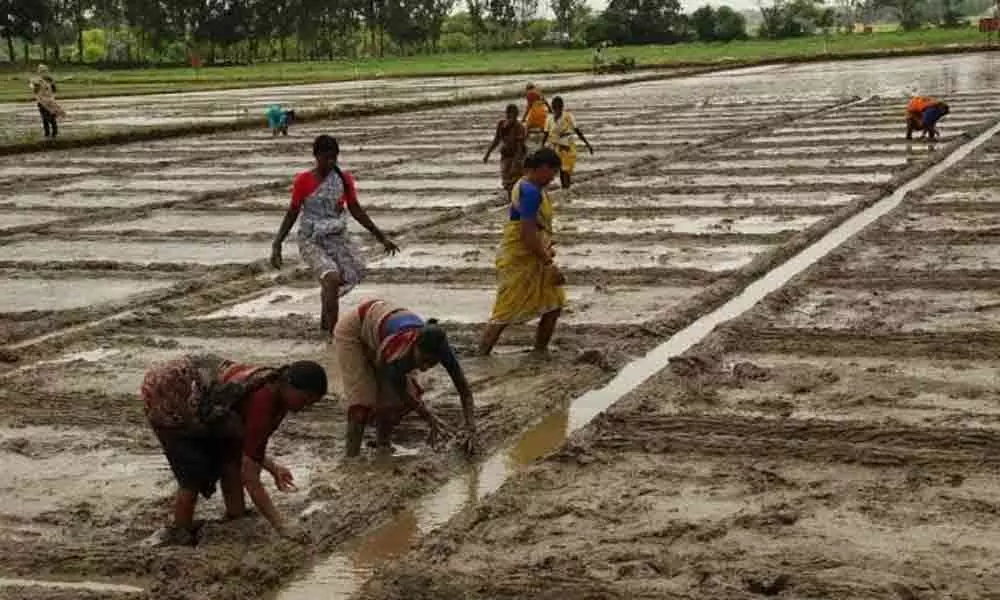Irrigation does more than deplete groundwater

In India, nearly 60 per cent of land area is used for agriculture, nearly half of that artificially irrigated. Historically, the introduction of irrigation technologies has fuelled the country's 'Green Revolution' and helped boost crop yield.
In India, nearly 60 per cent of land area is used for agriculture, nearly half of that artificially irrigated. Historically, the introduction of irrigation technologies has fuelled the country's 'Green Revolution' and helped boost crop yield.
But it comes at the cost of heavy consumption of freshwater and groundwater resources.
A new study published in the journal Climate Dynamics suggests that irrigation practices may be affecting more than just groundwater tables.
A team of researchers from the Centre for Atmospheric Sciences at the Indian Institute of Technology in Delhi used computer simulations and sophisticated global climate models to analyse the effects of irrigation on the climate in India.
The study found that irrigation decreases regional temperatures during crop growing seasons by as much as 3-4 degrees Celsius over the most heavily irrigated areas (primarily the Indo-Gangetic plains). This cooling, in turn, affects the monsoon cycle and alters rainfall amount differently in different regions.
"When the land surface absorbs sunlight, some of the energy is used up in evaporating the available water in the soil. If there is no (or limited) water, then more of that energy goes into heating up the surface," Krishna Achuta Rao, professor at the Centre for Atmospheric Sciences at the Indian Institute of Technology (IIT) Delhi and one of the authors of the study, told this writer.
"If more energy goes into evaporating water, the surface is cooler — just like if you splash water onto your face in the summer heat and feel cooler when it evaporates consuming your body heat," he added.
At first glance, this may sound like a good deal — irrigation helps counteract some of the temperature rise from increasing greenhouse gases in the atmosphere.
But, the climatic effects of irrigation are not limited to cooler temperatures, it changes rainfall patterns as well.
"Irrigation leads to lower surface temperatures, causing lower thermal gradients (difference in temperature) between surface and air," Achuta Rao said. "This thermal gradient is responsible for drawing moisture from the oceans which drives the monsoon cycle. Lower thermal gradient means weaker monsoon and lower rainfall," he added.
There are, however, competing processes by which irrigation could affect local rainfall. When more water is available on the ground, there is more evaporation, which means more moisture in the air and more rainfall locally. This is called recycling.
Both processes can occur simultaneously in some places; one could overpower the other. "If recycling is more important than the moisture transport from the ocean, then the rainfall increases. Otherwise, it decreases," Achuta Rao said.
Researchers used a global atmospheric circulation model combined with a land and ocean model — Community Earth System Model (CESM1.2) — to analyse the climate effects of irrigation in India.
Several simulations were performed, with and without irrigation, with varying amounts of irrigation, keeping all other factors (eg, greenhouse gases, aerosols, and land use) constant.
CESM was one of the most sophisticated models in the world, said Govindasamy Bala, professor at the Centre for Atmospheric and Oceanic Sciences at the Indian Institute of Sciences in Bengaluru.
"It has a comprehensive treatment for the land surface processes … it can simulate crops and it has some simple representation for irrigation too," he told DTE. The study's results were consistent with conclusions drawn from previous such work that he participated in, Bala added.
The study found that irrigation decreases the regional land surface maximum and minimum temperatures by nearly 3°C and 4°C, respectively, during the heavy irrigation months of April-May-June (pre-monsoon).
This explains why temperatures have not risen as expected in some parts of India, based on recent global warming trends. Irrigation is partly masking the otherwise rising temperatures.
Certainly, temperatures over the Indo-Gangetic plains have not increased as much as over the other parts of India. This is also seen in the extreme temperatures being relatively flat over time," Achuta Rao said.
The surface cooling, in turn, leads to a decrease of the land-sea temperature contrast in the pre-monsoon months which could delay the onset of monsoon, and also reduce the strength of rainfall.
As mentioned above, there are other competing factors such as higher moisture levels in the air that also impact rainfall amounts. In agreement with previous studies, the simulations showed an increase in summer rainfall over the arid western region and a decrease over the wet eastern part of the Gangetic basin.
Overall, the study found a decrease in the range of 1.5 to 4.2 per cent in the all India summer monsoon rainfall.
Ironically, irrigation is supposed to compensate for low rainfall during weak monsoon seasons. But, it may itself be contributing to the weakening of monsoons.
"I would generally trust the temperature change results. For rainfall changes, it would be important to see robustness in the pattern of changes by looking at a host of climate models which perform similar experiments," Bala said.
The authors themselves point out in the study that there is considerable scientific uncertainty related to climate effects of irrigation at the local and global scale. While the exact amount of change is debatable, it is clear that there are unintended consequences to unsupervised irrigation.
"If we are over-irrigating (most farmers in India do what can be termed flood irrigation), it is certainly something that needs to be corrected," Achuta Rao said.
"By doing it in a more measured fashion, the large impact on rainfall can be avoided and water can be conserved better without depleting scarce groundwater resources," he added.
(Courtesy: Down To Earth)

















